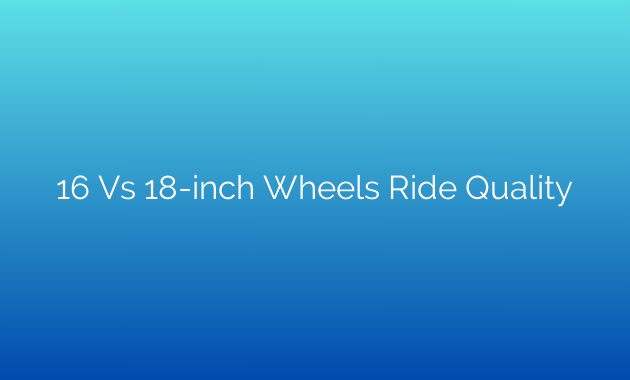Contents
- 1 16 Vs 18-inch Wheels Ride Quality
- 1.1 The 16-inch Wheel Experience
- 1.2 The 18-inch Wheel Experience
- 1.3 Choosing the Right Wheel Size for You
- 1.4 Conclusion
- 1.5 Frequently Asked Questions (FAQs)
- 1.5.1 1. Will switching from 16-inch to 18-inch wheels affect my fuel efficiency?
- 1.5.2 2. Are 18-inch wheels more prone to damage than 16-inch wheels?
- 1.5.3 3. Can I switch from 16-inch to 18-inch wheels without modifying my vehicle?
- 1.5.4 4. Do 18-inch wheels provide a better grip than 16-inch wheels?
- 1.5.5 5. Can I switch back to 16-inch wheels if I am not satisfied with the ride quality of 18-inch wheels?
16 Vs 18-inch Wheels Ride Quality
When it comes to choosing the right wheel size for your vehicle, the debate between 16-inch and 18-inch wheels is common among Car enthusiasts. Both options have their own set of advantages and disadvantages, which can significantly impact the overall ride quality. In this article, we will delve into the differences between these two wheel sizes, considering factors such as comfort, performance, and handling. By the end, you will have a better understanding of which size is best suited for your driving needs.
The 16-inch Wheel Experience
16-inch wheels are often associated with smaller vehicles and compact cars. They offer several benefits that are worth considering. One of the primary advantages of 16-inch wheels is their ability to provide a smoother and more comfortable ride. The larger sidewall of the tire allows for more flexibility, resulting in better shock absorption over bumps and potholes. This can greatly enhance the overall driving experience, especially on rough or uneven road surfaces.
Furthermore, the increased tire sidewall on 16-inch wheels provides a greater cushioning effect, reducing the impact transmitted to the vehicle’s suspension. As a result, passengers can enjoy a more stable and controlled ride, minimizing vibrations and road noise. This is particularly beneficial for those seeking a quiet and relaxed driving experience.
However, it is important to note that 16-inch wheels may not be the best choice for those who prioritize high-performance driving. The increased sidewall height can lead to more tire flex, negatively affecting the responsiveness and handling of the vehicle. Additionally, the larger sidewall can result in a slightly slower acceleration due to increased rotational mass.
The 18-inch Wheel Experience
On the other hand, 18-inch wheels offer a different set of advantages and considerations. These larger wheels are often associated with sportier or more luxurious vehicles. One of the main benefits of 18-inch wheels is their enhanced grip and improved cornering abilities. The shorter and stiffer sidewalls provide less flex, allowing for quicker response to steering input and better overall handling.
In addition, 18-inch wheels can provide a more aggressive and stylish look to your vehicle. The larger diameter and wider width of the wheels give a more muscular and commanding appearance. This aesthetic appeal can greatly enhance the visual presence of your car, attracting attention and turning heads wherever you go.
However, it is crucial to consider the potential downsides of opting for 18-inch wheels. The reduced sidewall height means there is less cushioning and shock absorption compared to 16-inch wheels. Consequently, the ride quality may be slightly compromised, especially on rough road surfaces. The shorter sidewalls also make the tires more susceptible to damage from potholes or other road hazards.
Choosing the Right Wheel Size for You
Ultimately, the decision between 16-inch and 18-inch wheels depends on your individual preferences and driving needs. If comfort and a smooth ride are your top priorities, 16-inch wheels may be the better choice. On the other hand, if you value performance and a sportier appearance, 18-inch wheels might be more suitable.
Consider factors such as your typical driving conditions, the type of vehicle you own, and your personal preferences when making your decision. Additionally, consulting with a professional mechanic or tire specialist can provide valuable insight and guidance based on your specific vehicle model.
Conclusion
Choosing the right wheel size is an important decision that can greatly impact your overall driving experience. Whether you opt for the comfort of 16-inch wheels or the performance of 18-inch wheels, it is essential to understand the trade-offs and considerations associated with each option. By considering factors such as comfort, handling, and appearance, you can make an informed decision that aligns with your individual needs and preferences.
Frequently Asked Questions (FAQs)
1. Will switching from 16-inch to 18-inch wheels affect my fuel efficiency?

Yes, larger wheels generally have a small negative impact on fuel efficiency due to increased rolling resistance. However, this difference is usually minimal and may not be noticeable in everyday driving conditions.
2. Are 18-inch wheels more prone to damage than 16-inch wheels?
Due to their shorter and stiffer sidewalls, 18-inch wheels may be slightly more susceptible to damage from potholes or road hazards compared to 16-inch wheels. However, regular maintenance and cautious driving can help minimize the risk of damage.
3. Can I switch from 16-inch to 18-inch wheels without modifying my vehicle?
In most cases, switching from 16-inch to 18-inch wheels can be done without any major modifications to your vehicle. However, it is crucial to ensure that the new wheel size is compatible with your vehicle’s specifications and does not interfere with the suspension or brake components.
4. Do 18-inch wheels provide a better grip than 16-inch wheels?
Yes, 18-inch wheels typically offer improved grip and handling due to their shorter sidewalls and wider tire contact patch. This can enhance the overall performance and cornering abilities of your vehicle.
5. Can I switch back to 16-inch wheels if I am not satisfied with the ride quality of 18-inch wheels?
Yes, it is possible to switch back to 16-inch wheels if you find that the ride quality of 18-inch wheels does not meet your expectations. However, it is recommended to consult with a professional to ensure compatibility and to address any potential issues during the transition.
